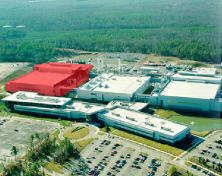uild the shell and eventually
the business will come.
That wasn’t the original plan, but it turned out
to be the path Infineon Technologies took before fina lly greenlighting
its US$1-billion investment in Richmond, Va., to expand manufacturing
capacity of advanced DRAM chips on 300-mm. wafers.
 |
| After three years on hold, Infineon is moving ahead with its $1-billion, 300-mm. fab in Richmond, Va. The facility will eventually add 800 jobs at the huge complex. |
Understanding Infineon’s Richmond saga requires a
flashback to 2000, when the global semiconductor industry hit record sales
of $204 billion. During those heady days, Infineon was moving with its
growth plans in Richmond, building a $200-million addition to its complex
and the necessary infrastructure for ramping up the new 300-mm. fab. But
then, things turned sour in the industry. Worldwide sales plummeted to
$139 billion in 2001, and the project was shelved in hopes of better days.
“It didn’t make sense to add capacity in that environment,”
says Robert LeFort, president of Infineon Technologies North America,
noting that Infineon continued to invest in the latest technology at Richmond
three times in the ensuing three years.
The industry gradually recovered and is now performing
better than ever, with global sales likely to top the 2000 record, LeFort
says. “This year really has been good for the industry as a whole,” he
says. “We’re seeing solid growth. Basically, all our markets are strengthening
and the consumer is driving the market. PCs are selling well, as are wireless
handsets. Even automotive electronics are doing quite nicely.”
Lefort is unabashedly bullish on the industry, saying
a strong second half of 2004 could push annual growth well above 20 percent.
Infineon is now proceeding with the long-delayed
project, bringing total investment to more than $1.2 billion. The 550,000
sq.-ft. (51,000 sq.-m.) fab will begin production in early 2005 with a
monthly capacity of 25,000 wafers. Infineon will continue to operate its
800,000 sq.-ft. (74,320 sq.-m.) plant. The expansion will more than double
the site’s DRAM capacity and will add 800 employees, increasing the work
force to 2,550.
Heading into 2005, demand for consumer electronics
continues to be strong and in turn is driving semiconductor demand. And
as consumer products become more sophisticated, they use more electronics.
“A cell phone a few years ago was relatively primitive,”
LeFort says. “Now, it has an MP3 player, a camera and a whole address
book. All of those functions require more electronics and they are housed
in basically the same unit.”
“Richmond has been a key manufacturing facility in
our global manufacturing cluster,” LeFort adds. “Based on its performance
and time to market, we made the investment to put 300-mm., 12-inch wavers
in the facility. This will now give us a state-of-the-art facility on
three continents with one also in Germany and a joint venture ramping
up now in Taiwan.”
Inotera Memories is the name of the Taiwan joint
venture between Infineon and Nanya Technology Corp. The site, which is
ramping up at HwaYa Technology Park, is the world’s largest 300-mm. DRAM
production site, with a capacity of more than 50,000 wafer starts per
month when fully operational.
“The name of the game is who can have the smallest
chip,” LeFort says. “We’ve gone through three shrinkings since we built
the shell in Richmond.”
LeFort likens the “shrinking” process to hitting
the reduce button on a copy machine. The result delivers the same content,
but in a smaller package. He notes that even though the project was delayed,
the company continued to invest heavily in technology at the Richmond
facility, keeping it up to date.
“Now, we are able to utilize the shell, utilize the
manufacturing expertise and the availability of talent in the area,” he
says. “It was an easy choice to make such a large investment.”